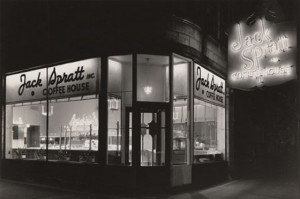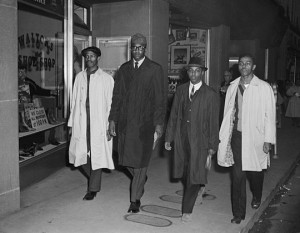
1941 (date accessed 24 April 2013) http://blog.chicagohistory.org/index.php/2010/01/south-side-sit-in/
CORE started conducted sit-ins as early as the 1940s. In 1943, the founding members of CORE staged their first sit in at the Jack Spratt Coffee House. The leaders sent group members to the coffeehouse where only the white members were served. After the Black members were denied service, the entire group refused to leave their seats until all members were served. As other customers began to participate, the coffeeshop manager’s called the police. CORE leaders, however, had already alerted the police of the demonstration claiming that the members were within their rights. The manager’s eventually served the entire group and the coffeeshop continued to serve both Black and white customers.

David Richmond (from left), Franklin McCain, Ezell Blair Jr., and Joseph McNeil Feb. 1, 1960 http://ncpedia.org/history/20th-Century/greensboro-four
CORE did a few more sit-ins in St. Louis in 1949 and Baltimore in 1952 but none of them got the same amount of press and recognition as the ones in North Carolina. On February 1, 1960, four Black students in Greensboro refused to leave Woolworth’s until they were served. Over the next few weeks, the local newspapers reported about their efforts and support grew with each day. Ezell Blair Jr., the president of the Greensboro CORE chapter, stated “…It is time for someone to wake up and change the situation…and we decided to start here.” Following the success at Woolworth’s, CORE organized more sit-ins and trained students in the tactics and strategies of nonviolent resistance. Over the past few years, sit-ins have spread throughout the South in Tennessee, Virginia, South Carolina, and Florida. Students in the New York City, as an act of solidarity, protested Woolworth’s. A Columbia student who led the protest was quoted saying that an “injustice anywhere is everyone’s concern”. By July 1960, the Woolworth’s chain desegregated and served both Black and white customers.
